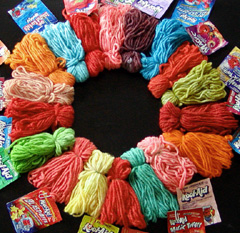And it is time, as you well know, for that wonderful pseudo-beverage, Kool-aid. This year, instead of drinking this freakishly sweet liquid, why not do something healthier and use it to dye fiber?
 Source: http://www.knitty.com/issuefall02/images/koolaid1.jpg
Source: http://www.knitty.com/issuefall02/images/koolaid1.jpgI am not going to explain the process of how to use kool-aid to dye fiber. There are plenty of good articles on that. (see Knitty: http://www.knitty.com/issuefall02/FEATdyedwool.html for an exellent one) I will highlight, though, that Kool-aid is an exellent way to begin an exploration of fiber dying in a food-safe and non-toxic manner (as much as we can call kool-aid nontoxic!)
What I want to highlight here, though, is some factors you can keep in mind that will give you new directions for creativity and design.
The first thing I would like to talk aobut is _when_ you dye your fiber. You can do this at any point from raw wool (I would recommend making sure it is well-washed first) to the final garnment or product. At each point you will be able to control different aspects of the final presentation. For example, dying raw fiber will give you great opportunities to blend, ply, and variegate your color choices during your spinning. Once spun, you can more easly control chunks of color and repitions. In the final garnment, you can pour your dye in partiuclar patterns to create swirls, lines or spots.
Another thing to keep in mind with Kool-aid is the control you have over your colors. This may take a significant amount of experimentation, but the colors are infinately blenable, so go wild with combinations. Moreover, you can actually control intensity through the amount of kool-aid you use. (NOTE: the intensity is based on the ratio of kool-aid to fiber, NOT the amount of water used.)
A third, and for today final, use of kool-aid is for overdying. Got some yarn you don't like? Want to dull out that eye-stinging yellow? Drop your yarn in a pot, and see what you can do! It is a good idea to consult your color wheel before adding anything to preexisting dyes, as certain colors will combine better than others. A great introduction to this can be found in the Twisted Sisters Sock Workbook. (See: http://www.interweave.com/knit/books/twisted.asp)
So go out and have fun! Don't hesitate to incorporating dying into your fiberwork. After all, Spring is about trying new things.

No comments:
Post a Comment